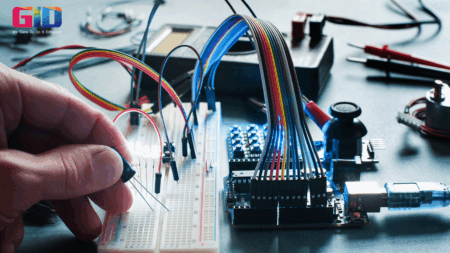Step-by-Step Guide to Filing a Patent in the USA
How to File a Patent in the United States is a crucial step for inventors and innovators to protect their new product ideas and inventions. Patents grant exclusive rights to the inventor, allowing them to prevent others from making, using, or selling their invention without permission.
Filing a patent in the USA involves several crucial steps that ensure your invention is legally protected. To start, you’ll need to prepare a detailed patent application that includes a thorough description of your invention, claims defining its unique aspects, and any necessary drawings or diagrams. This application must be filed with the United States Patent and Trademark Office (USPTO). Before you file a patent, conducting a comprehensive patent search is recommended to confirm that your invention is novel.
Once you file a patent application, it undergoes examination by a USPTO examiner, who will review the claims and may request additional information or amendments. The patent process can be lengthy and complex, often involving multiple rounds of correspondence with the USPTO. If your application is approved, you will receive a patent grant, which provides you with exclusive rights to your invention. To maintain these rights, you must file periodic maintenance fees.
Understanding how to file a patent and navigating the patent process efficiently is crucial for protecting your intellectual property. For assistance, consider consulting a patent attorney who can guide you through each step of filing a patent and help you address any challenges that may arise.
If you have a new product idea and are seriously thinking about new product development then in this comprehensive guide, we will walk you through the step-by-step process of filing for a new product patent in the USA.
Step 1: Conduct a Patent Search Before file a Patent application, it is essential to conduct a thorough patent search to ensure your invention is novel and does not infringe upon existing patents. Use the United States Patent and Trademark Office’s (USPTO) online database to search for similar inventions and relevant prior art.
Step 2: Determine the Type of Patent Application The USPTO offers three main types of patent applications: utility patents (for new processes, machines, or compositions of matter), design patents (for new, original, and ornamental designs), and plant patents (for new varieties of asexually reproduced plants). Identify which category your invention falls into to proceed with the appropriate application file a Patent.
Step 3: Prepare the Patent Application Gather all the necessary information and documentation required for the file a Patent application. This typically includes a written description of the invention, drawings or diagrams (if applicable), and any supporting documentation. Consider seeking assistance from a patent attorney or agent to ensure accuracy and completeness. If you are completely new to the domain, and not sure where to start from, then you can talk to product development experts at GID Company. You can Call Jim at +1714-323-1052 to get all your questions answered correctly. You can also refer to the product development FAQ section on the website for general information.
Step 4: Determine the Filing Strategy, decide whether to file a provisional or non-provisional patent application. A provisional application establishes an early filing date and allows you to use the term “patent pending” while providing you with 12 months to file a non-provisional application. A non-provisional application starts the examination process with the USPTO and must include all the necessary details of the invention.
Step 5: Prepare the Application Forms Complete the appropriate USPTO forms for your chosen patent application. For utility patents, the main form is the Utility Patent Application Transmittal Form (Form PTO/AIA/15A), accompanied by the specification (written description) and drawings (if applicable). Design and plant patents have their respective forms (e.g., Design Patent Application Transmittal Form – PTO/AIA/08). Ensure you have all required documents to successfully file a patent.
Step 6: After you file a patent Application, Submit your completed patent application and associated forms to the USPTO. You can file a patent electronically through the USPTO’s Electronic Filing System (EFS-Web) or by mail. Be sure to include the necessary filing fees, which vary based on the type of patent application and entity status (individual, small entity, or large entity).
Step 7: Track the Application and Respond to USPTO Actions After filing, you will receive an application number and filing receipt. Monitor the progress of your application using the USPTO’s Patent Application Information Retrieval (PAIR) system. If the USPTO raises any objections or rejections, respond promptly and comprehensively within the specified timeframe to address their concerns.
Step 8: Patent Examination and Prosecution The USPTO will review your application, examining its patentability and conducting a prior art search. They may issue an office action with objections or rejections that you must address. This back-and-forth process is known as patent prosecution. Consult with a patent attorney or agent if you encounter complex legal or technical issues during this stage.
Step 9: Patent Issuance or Appeal If the USPTO determines that your invention meets all patentability requirements, they will issue a Notice of Allowance. Pay the necessary issue fees and any maintenance fees to finalize the patent granting process. If your application is rejected, you can appeal the decision before the Patent Trial and Appeal Board (PTAB) or seek further legal remedies.
Filing a patent in the USA requires a detailed process to protect your new invention. To effectively file a patent, you need to start with a thorough patent search, prepare a detailed application, and manage the examination and prosecution phases. Engaging with a patent attorney or agent can greatly enhance your chances of success. They provide crucial guidance and expertise to navigate the complexities of filing a patent. For personalized support and professional advice on how to file a patent, consulting with experts can make the process smoother and more effective, ensuring your innovation is well-protected.
In case, if you are not interested in contacting any patent attorney or agent, then you can get in touch with the product development expert at GID Company – James Grimes. James Grimes is the engineering and design leader and mentor at GID Company. For a free telephonic consultation, you can call him at +1714-323-1052 or send your questions with the help of the contact us form on the website.

















